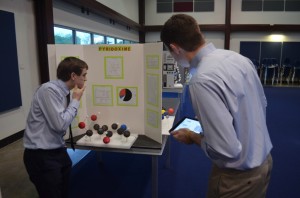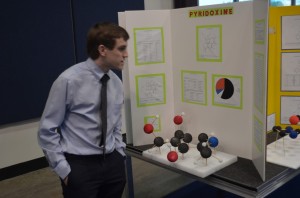On Monday, March 30th, the sophomore class will once again walk through the doors of the Terry Center with the highlight-project of their chemistry course: the molecule models. Ranging from testosterone to trinitrotoluene, or TNT, the molecule models, along with their accompanying papers and research, are the byproduct of the ceaseless determination each individual sophomore had to put forth.
As colorful and bright as the molecule projects look, it can be easy to forget about the excruciating work and planning put into the models that took nearly the entire year to complete- if you’re not a sophomore, of course.
Around October, a first-come-first-served system was adopted to assign the chemistry students their molecular compound from a predetermined list that included caffeine, tylenol, serotonin, acetaminophen and “two bucky balls!” that were noticeably science teacher Mr. John Nugent’s personal favorite. Once each molecule was chosen, the sophomores headed to the draft table, conducting in-depth research on certain properties of their molecule, like solubility and toxicity, and constructing the molecular structure on the computer program Marvin Sketch.
The unique program, which lays out the 3-D geometric design of each molecule, helped determine the bond-angles, bond-lengths, and general orientation that would be needed for the actual physical construct. And on top of all that, each student was required to write an extensive, multiple-page paper detailing everything about the molecule, from its general properties to everyday use and legality around the world.
determine the bond-angles, bond-lengths, and general orientation that would be needed for the actual physical construct. And on top of all that, each student was required to write an extensive, multiple-page paper detailing everything about the molecule, from its general properties to everyday use and legality around the world.
 After all the preliminary work was completed, the construction on the model began. Flocking to craft and hobby stores all across the DFW metroplex to buy supplies, the students stocked up on material that predominantly included Styrofoam balls, toothpicks and spray-paint, but also included things like Play-Do, and paper for paper-mache atoms.
After all the preliminary work was completed, the construction on the model began. Flocking to craft and hobby stores all across the DFW metroplex to buy supplies, the students stocked up on material that predominantly included Styrofoam balls, toothpicks and spray-paint, but also included things like Play-Do, and paper for paper-mache atoms.
While the chemistry students didn’t seem to mind the paper as much, there was a general consensus of frustration and annoyance with building the actual model. Justin Rubenstein ’14, an honors chemistry student, believed that “putting the bonds at the correct angles into the styrofoam balls was painstaking work,” while fellow peer, Alessandro Ricciardi ’14, who built an epinephrine molecule, underscored the fact that the hardest aspect of the project “was building it because it took much longer than anyone would think.” No matter their complaints, most sophomores appeared to have their projects completed by the end of the week, except for the most extreme procrastinators.
 And despite the general dislike of the building phase, Mr. Nugent remarked that he has gotten a “pretty positive reaction” from his students about the project and that by the end of the year, when their projects are completed and presented in the Terry Center, the students “feel pretty proud of their work.” Above all, students should learn the “value of preliminary work” as well as the ability “to synthesize all the information and topics gathered over the year” that are incorporated in the project that Mr. Nugent and all the other chemistry teachers hold so highly.
And despite the general dislike of the building phase, Mr. Nugent remarked that he has gotten a “pretty positive reaction” from his students about the project and that by the end of the year, when their projects are completed and presented in the Terry Center, the students “feel pretty proud of their work.” Above all, students should learn the “value of preliminary work” as well as the ability “to synthesize all the information and topics gathered over the year” that are incorporated in the project that Mr. Nugent and all the other chemistry teachers hold so highly.
Expect the molecule projects to be nothing less than spectacular when they are on display Monday and Tuesday of next week. As long as the “kinetic-molecular chaos” is kept to a minimum, as Mr. Nugent hopes, everyone who attends will re-discover the fascinating world from a molecular point of view.







